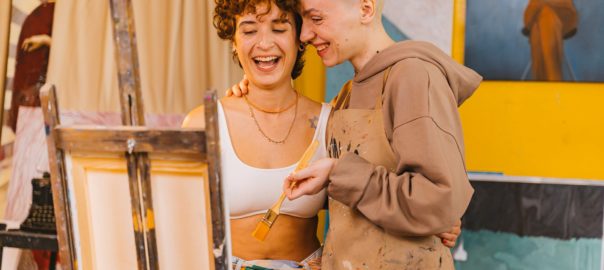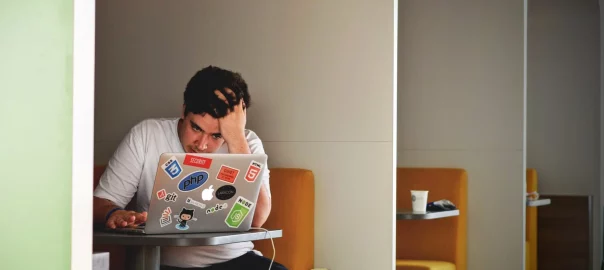Last week, we explored the most common causes of “art block,” which prevents many artists from expressing themselves and bringing their visions to life. This issue can exacerbate stress, anxiety, self-esteem issues or depression, so figuring out how to cure art block may improve your mental and emotional health. Let’s dive in with a solution for each of art block’s most common causes.
1. Fatigue
Whether your body is tired or your brain is, trying to create when you’re exhausted is a quick recipe for stumbling. If this feeling comes up every time you try to create art, or you find yourself dreading the artistic process, you might also be dealing with burnout. Burnout may be caused by a job or school that overworks you, or it may happen to artists who push themselves to create a lot of art in a short period of time.
Whatever kind of fatigue you’re dealing with, the answer is rest. Give yourself permission not to make art for at least a week. If you find yourself itching to create before the week is up, great! If you’re still tired afterward, you may need more time off (especially if art caused the burnout). Or you may need to lighten your other responsibilities so your brain won’t be too fried to create.
2. Inability to Focus
If you can’t focus or get attached to any art ideas, it may be because of fatigue, as above. But sometimes this issue can happen on its own, as is common for people with stress, anxiety, or ADHD.
My go-to here is to do small, brief sketches or doodles. If you want to make a bigger or more complex project, but aren’t sure if your brain can stick to it right now, try thumbnailing the image or concepts a few times. Keep it simple! If you can draw a small, easy image, you’ll get the satisfaction from finishing something, which may spark more interest from your brain. Plus, thumbnails can help you work out kinks in the art idea before you try to make it “for real.”
If small sketches or thumbnails don’t help, try taking a break. If you can’t stop thinking about something non-art-related, try writing those thoughts down or talking them through with a friend. Your brain may need to get some exercise, sleep on it, or resolve its other preoccupations before it can dive into art.
3. Decision Paralysis
You’ve got the energy. You’ve got the attention span. But you can’t put pen to paper. You may be dealing with decision paralysis.
Decision paralysis comes in two forms. First, there’s the inability to choose what to create. Fortunately, working out how to cure art block for this is pretty straightforward. You could take requests, such as in Reddit Gets Drawn, or prompts from random generators. You could revisit one of your old works and try making it again to see how your style has changed.
If you do have ideas, but can’t decide between them, try creating an “idea document.” Here you’ll list all the ideas for things you want to create. Toss short descriptions of each idea in there as it comes to you, and set aside all of them but one for now. This can help your brain stop worrying about fear of missing that one really cool idea.
The second type of decision paralysis artists encounter is blank page syndrome: you’ve got the idea, and can probably see it in your head, but it’s hard to get it onto the page.
A couple different things could help here. First, collect references and inspirational material for your subject, and try tracing or copying them. Familiarizing yourself with the subject will help you put your own spin on it. Second, make thumbnails, and experiment with lots of different ways to start. Don’t worry if they look bad – they aren’t the “real” art you’re trying to make, just rough drafts.
But blank page syndrome can be caused by something deeper…
4. Self-criticism and Pressure
One of the challenges of art is that it forces you to confront your own level of ability – or lack thereof. You can’t help but compare your results to what’s in your head, or to other people’s art. And for many of us, flaws in our art feel like flaws in ourselves.
How to cure art block for this? I suggest you make bad art on purpose. Scribble all over the page. Draw wonky perspective or mismatched eyes. Then do it again, and again – an ugly doodle every day for a week, if you can.
The point of this is to show the fearful part of your brain that it’s okay to mess up, because you’ll always have another chance. It will also teach your brain that you can still create art even while feeling intimidated or anxious. You might even like some of the results.
The second thing I’ve found helpful for most people is to compare your work to your previous works, not to other people. It doesn’t matter if your skill isn’t where you want to be yet. As long as it’s getting better over time, it will eventually get there. Remember that every creator you admire started off as a novice like you, and took a long time to get skilled, too.
5. How to cure art block when you have mental health issues?
The hard truth is, art block is sometimes caused by things you can’t fix with a single blog post like this one. Self-criticism may come from low self-esteem, anxiety, or depression. Lack of focus may come from ADHD or other disorders. I don’t want to alarm you – usually art block isn’t something to seriously worry about. But if you’ve been struggling with your mental health, it’s very likely to interfere with your art.
The good news is that there are more resources for recovery than ever before. Art classes can be a great way to build your confidence and find support, and you can also find meetup groups and forums for artists. For a mental health focus, you can look into support groups, group counseling, or working with a therapist. Drop me a line if you have questions about ways to find support or are interested in starting therapy.

